Leg Braces for Scoliosis: Mechanisms and Innovations


Intro
Scoliosis presents a complex challenge that intertwines both physical and psychological dimensions. This condition, characterized by an abnormal curvature of the spine, affects not only posture but can also lead to a myriad of health issues over time. As such, leg braces emerge as a significant component in managing scoliosis, aiding in treatment and contributing to patient well-being. Understanding how these braces function, their design variances, and the latest advancements can offer greater insights into their use and effectiveness.
The intricacies of scoliosis go beyond just the spine; they encompass the alignment of the entire body, including the legs. This connection underscores the importance of leg braces in supporting patients' overall health. The potential enhancements in materials and design, combined with real-world patient experiences, illustrate a changing landscape in orthopedic support. As we venture further into this discussion, we will explore the key concepts surrounding leg braces, assess their practical applications, and consider future directions in research and innovation.
Equipped with this knowledge, students, researchers, educators, and healthcare professionals will find a well-rounded examination of the multifaceted nature of scoliosis treatment through leg braces. This is not merely a study of hardware but an exploration of supportive technology that aims to improve life quality for individuals navigating the challenges posed by scoliosis.
Key Concepts
Definition of Primary Terms
Leg Braces: Devices designed to provide support, stabilization, and alignment to the lower limb, aiding mobility and enhancing function in individuals with orthopedic conditions.
Scoliosis: A type of spinal deformity characterized by a sideways curvature of the spine, often occurring during the growth spurts before puberty.
Orthosis: A supportive or corrective device applied externally to the body to align, prevent, or correct deformities or improve the function of movable parts.
Related Concepts and Theories
The study of leg braces intersects with a variety of medical and engineering principles. Concepts such as biomechanics, material science, and patient-centered design resonate throughout the discussion.
- Biomechanics: The study of mechanical laws relating to the movement or structure of living organisms, particularly how forces affect body movement and balance.
- Material Science: Involves the study and application of materials to create stronger, lighter, and more adaptive devices that meet the needs of scoliosis patients.
- Patient-Centered Design: The practice of designing products or systems that prioritize the needs, preferences, and experiences of the end-users, especially crucial in healthcare contexts.
In essence, the integration of these areas fosters an innovative environment where leg braces are continuously refined to meet the complexities of treating scoliosis. Understanding these key concepts is essential for comprehending the broader implications of leg braces as they relate to patient outcomes and treatment efficacy.
Understanding Scoliosis
Scoliosis is more than just a medical term; it represents a complex interplay of biological, environmental, and social factors that demand careful consideration. Grasping the essence of scoliosis is essential for comprehending how interventions, particularly leg braces, can make a significant difference. Since scoliosis often emerges during key developmental years, understanding its implications lays the foundation for improved outcomes as individuals navigate their treatment options.
Definition and Types of Scoliosis
To get to the heart of scoliosis, one must first define it. Scoliosis is characterized by an abnormal curvature of the spine, often appearing as an "S" or "C" shape rather than the usual straight alignment. This condition can be categorized into several types based on its origin:
- Idiopathic Scoliosis: The most common type, with no known cause, typically developing in adolescents.
- Congenital Scoliosis: Results from malformations of the vertebrae that occur during fetal development.
- Neuromuscular Scoliosis: Associated with conditions such as cerebral palsy or muscular dystrophy, impacting muscle control and balance.
- Degenerative Scoliosis: Occurs in adults, often stemming from age-related changes or trauma.
Understanding these distinctions is necessary, as they dictate treatment approaches and outcomes.
Epidemiology and Prevalence
In the grand landscape of public health, scoliosis holds significant relevance. Research suggests that this condition affects approximately 2-3% of the population, with varying prevalence based on age and sex. For instance, girls are more susceptible to idiopathic scoliosis than boys, particularly during the peak growth spurts before puberty.
The distribution of scoliosis also highlights geographic and ethnic disparities. Some studies indicate that Caucasian populations show a higher incidence compared to Asian or African populations. Recognizing these figures is crucial not only for clinical practice but also for informing awareness and prevention initiatives in schools and communities.
Etiology and Pathophysiology
Understanding the etiology of scoliosis involves peeling back layers of complexity. While the exact cause remains a mystery for idiopathic scoliosis, researchers have identified several factors that contribute to its development:
- Genetic Predisposition: Family history can elevate risk, hinting at underlying hereditary factors that might be at play.
- Neuromuscular Issues: Conditions like muscular dystrophy or myelomeningocele can disrupt normal spinal alignment, leading to scoliosis.
- Biomechanical Factors: Imbalances in muscle strength and control may result in uneven pulling on the spine.
The pathophysiology of scoliosis involves not just curvature but also associated changes in the thoracic cavity, affecting lung function and overall health. Furthermore, the sagging of spinal discs and the loading of vertebrae can create a cascade of painful symptoms, making it evident why early intervention is vital in managing scoliosis effectively.
Understanding these components of scoliosis provides a framework that underscores the importance of proper treatment modalities, including the use of leg braces, as the journey towards managing this condition unfolds.
The Role of Bracing in Scoliosis Management
The use of leg braces in managing scoliosis plays a critical role in both the physical alignment of the spine and the overall health of the patients. Scoliosis, a curvature of the spine, can lead to a host of complications if not properly managed. This section delves into the nuances of how leg braces contribute to scoliosis treatment, their objectives, recommended practices, and the comparison of non-operative methods with surgical interventions.
Purpose of Leg Braces in Scoliosis
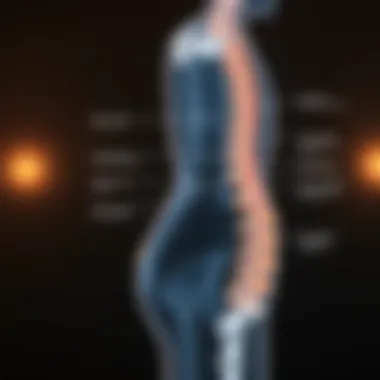
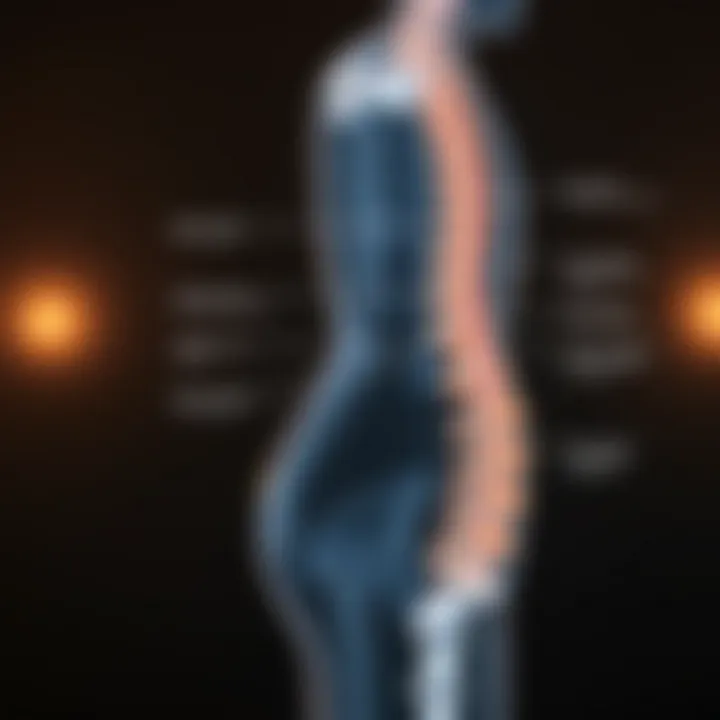
Leg braces serve multiple functions in managing scoliosis, primarily focusing on the alignment and stabilization of the spinal structure. One of the main purposes of these braces is to prevent further curvature progression, especially during the critical growth phases in adolescents.
- Support and Stability: Leg braces provide necessary support to the spine and pelvis, promoting improved posture and reducing the likelihood of worsening curvature. This can significantly enhance mobility and decrease discomfort.
- Pain Management: For many patients, wearing a properly fitted leg brace can alleviate pain associated with scoliosis. By distributing pressure evenly across the body, braces can minimize stress on certain areas of the spine, helping to mitigate pain during activities.
- Enhanced Functionality: In addition to support, leg braces can help improve overall functionality. By correcting alignment issues, they allow the individuals to engage in daily activities more comfortably and effectively.
Recommended Bracing Protocols
Establishing effective bracing protocols is essential for achieving desired outcomes in scoliosis treatment. The protocols often include:
- Initial Evaluation: Before beginning any bracing regimen, a thorough evaluation by a specialist is crucial. This includes medical history, physical assessments, and often imagery scans like X-rays to determine the severity of the curvature.
- Customized Fit: Meaningful improvements typically begin with custom-fitted leg braces. These are tailored according to individual anatomies, ensuring comfort and enhancing compliance with wearing schedules.
- Gradual Adjustment: It’s vital to begin with a gradual increase in usage duration. Initial recommendations might suggest wearing the brace for a few hours a day, gradually increasing as the patient adapts.
- Regular Follow-up: Continuous monitoring is essential to track changes in spinal curvature and overall effectiveness. Adjustments to the brace may be needed as the patient grows or as conditions change.
Non-Operative versus Surgical Options
When discussing scoliosis treatment, the comparison between non-operative, such as bracing, and surgical options becomes pertinent.
- Non-Operative Options: Bracing represents a widely accepted non-operative option. It's typically viewed as the first line of defense for managing mild to moderate scoliosis. The advantages here include:
- Surgical Options: Surgery is usually reserved for more severe cases or when bracing has not produced desirable results. Common procedures include spinal fusion which aims to correct severe deformity.
- Non-invasive, which means no surgery risks.
- Can often suffice to prevent progression of the curvature.
- Less recovery time, allowing the patient to maintain a normal lifestyle.
- Higher immediate risks associated with any surgical intervention.
- Recovery times are significantly longer, often involving physical rehabilitation.
- While effective, surgery may not guarantee complete correction and may have limitations in mobility post-operation.
Types of Leg Braces for Scoliosis
Understanding the various types of leg braces specifically designed for scoliosis is vital for effective management and treatment. Each type has its unique mechanisms, applications, and advantages that contribute to improving the quality of life for individuals suffering from this condition. This section will break down the most common varieties of leg braces, focusing on their construction, purposes, and clinical implications.
Custom-Fitted Orthotics
Custom-fitted orthotics are tailored to the unique anatomical structure of each patient. By utilizing specialized imaging and measurement techniques, orthotists create braces that align perfectly with the patient's limbs and spine. This personalized approach ensures maximum comfort and effectiveness.
- Benefits:
- Reduces discomfort and skin irritation, which are common with off-the-shelf products.
- Enhances proprioception, allowing patients to become more aware of their body positioning.
- Optimizes alignment for the specific curvature of the spine, minimizing further progression of scoliosis.
While the initial cost for custom orthotics may be higher, they often yield better long-term outcomes. Satisfaction rates among users tend to be notably higher, as they feel more secure and confident in their mobility.
Dynamic Bracing Solutions
Dynamic bracing solutions represent a significant advancement in orthotic technology, combining support with flexibility. These braces allow for a range of motion, which can be important in ensuring that patients retain function while receiving necessary support for their spine.
- Key Features:
- Adjustable settings that accommodate growth and allow for refinements based on treatment progress.
- Integration of energy-storing materials that provide support while enabling dynamic movement.
- Lightweight design that promotes longer wear without fatigue.
Dynamic braces have been praised for their ability to support active lifestyles. Patients often find they can participate more fully in daily activities and exercises, which can be crucial for overall morale and rehabilitation.
Hybrid Braces
Hybrid braces combine elements of both rigid and dynamic designs, offering a balanced approach to scoliosis management. These braces support the spine effectively while allowing enough flexibility for patients to maintain their activities.
- Components:
- Rigid sections that provide targeted support where it is most needed.
- Flexible areas that allow for movement, making it easier to wear throughout the day.
- Aesthetic designs that help patients feel confident in using their braces in public settings.
The adaptability of hybrid braces can cater to various stages of scoliosis progression, which may lead to a more comprehensive treatment option. Doctors often recommend these for patients transitioning from treatment modes or growing adolescents needing frequent adjustments.
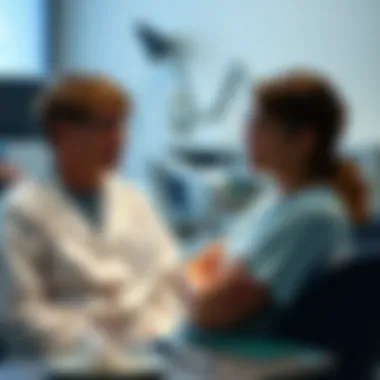
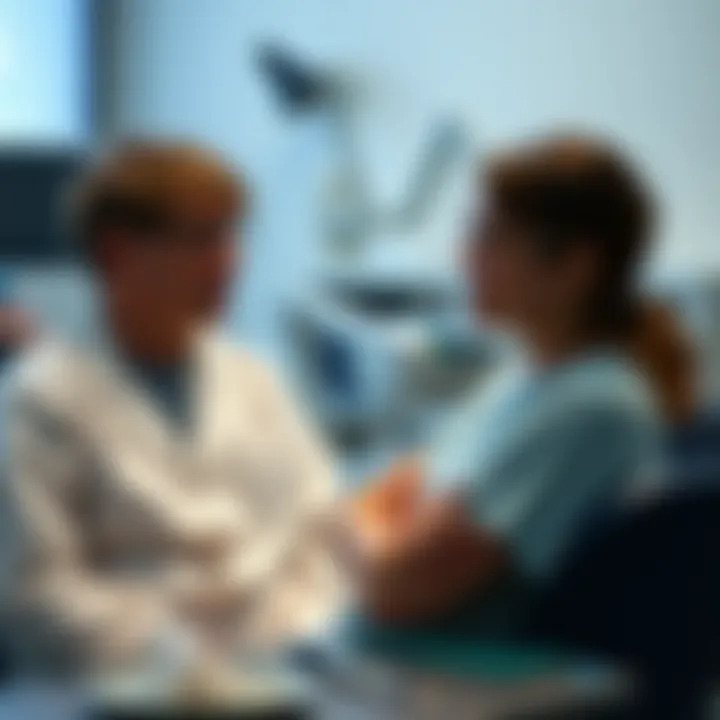
"The choice of leg brace should be carefully considered, as individual needs and the specifics of each curvature will vary greatly. Consulting with a professional who specializes in orthotics can lead to significant improvements in patient outcomes."
Materials and Design Innovations
The landscape of orthotic support for scoliosis is continuously evolving, driven by advancements in materials and design innovations. This evolution not only aims to improve the mechanical efficacy of leg braces but also enhances patient comfort and compliance. The emphasis on newer materials and innovative designs is paramount for healthcare professionals who are tasked with recommending the best treatment options for individuals affected by scoliosis.
Advancements in Orthotic Fabrics
Recent developments in orthotic fabrics are particularly noteworthy. Modern braces often utilize lightweight, breathable materials that prioritize both comfort and functionality. For instance, fabrics that integrate moisture-wicking technology serve to keep the skin dry and reduce irritation during prolonged wear. This can be crucial for children and adolescents, who may be less willing to adhere to treatment if they find it uncomfortable. Moreover, some fabrics are now engineered to have elastic properties, allowing for better mobility without compromising the brace's supportive functions.
In addition, the incorporation of antimicrobial properties in these fabrics helps to prevent skin infections, a common concern for those wearing braces. This improvement directly addresses some of the side effects associated with long-term brace use, making a significant difference in patient experiences.
3D Printing in Orthotic Manufacturing
Another groundbreaking development is the use of 3D printing technology in the manufacturing of leg braces. This approach allows for highly individualized and customized solutions that were previously difficult or time-consuming to create. By using 3D scanning technology, healthcare providers can capture the precise contours of a patient’s leg, and subsequently, a brace can be printed that fits perfectly.
This level of customization not only enhances comfort but also ensures that the brace provides the necessary support in critical areas. The speed of production is another benefit; whereas traditional methods can take weeks, 3D printing can dramatically reduce turnaround times to a matter of days. Additionally, the use of advanced polymers in 3D printing can produce lightweight yet durable braces, which can result in improved wearability for the patient.
Wearable Technology in Bracing
Adapting wearable technology into leg braces is yet another significant innovation. Smart brace technologies are emerging, equipped with sensors that monitor the patient’s movement in real-time. Such systems can provide valuable data on how the brace is being used and whether it is aligning with the intended therapeutic goals. This feedback mechanism can motivate patients, as they can see how their adherence affects their condition.
For example, a brace that can communicate with a smartphone app could allow both patients and their care teams to track usage patterns, discomfort levels, and any changes in mobility over time. This data-oriented approach to treatment not only helps ensure accountability but also plays a key role in fine-tuning the therapeutic approach for each individual.
"Innovations in materials and designs are redefining the possibilities in scoliosis management, offering customized solutions that align better with each patient's needs."
Epilogue
Ultimately, the push towards material and design innovations in leg braces lays the foundation for improved orthotic interventions in scoliosis. From advanced fabrics that enhance comfort and hygiene to cutting-edge technologies like 3D printing and wearables, each development serves to bridge the gap between effective treatment and patient experience. Such advancements mark a promising future for scoliosis management, as they promise to increase adherence and improve outcomes as well.
Efficacy of Leg Braces
The efficacy of leg braces in managing scoliosis is a pivotal topic in the broader discourse surrounding spinal health. These devices serve more than just a structural function; they also embody a holistic approach to treatment that weighs both physical and psychological factors. Understanding the effectiveness of these braces is crucial, as it informs patients and healthcare providers about the various outcomes tied to their use.
Outcomes of Bracing in Adolescents
Leg braces are often prescribed during adolescence, a critical growth period for many individuals with scoliosis. The primary goal is to prevent the worsening of spinal curves as growth plates are active. Studies have shown that when used consistently, these braces significantly reduce the rate of curve progression. For example, a longitudinal study found that adolescents who adhered to a prescribed wearing schedule of over 18 hours a day showed a 70% reduction in curve progression compared to those who wore the brace less frequently.
Moreover, there’s a noticeable improvement in psychological outcomes. Adolescents wearing braces often report enhanced body image and self-confidence due to feeling supported physically and mentally. This dual effect can motivate a more active engagement in their treatment plans, leading to better overall outcomes. This connection between bracing and emotional health demonstrates the multifaceted benefits of orthotic support in managing scoliosis.
Long-term Benefits and Risks
While the immediate benefits of leg braces are evident, it’s important to understand the long-term considerations. Some of the potential benefits include:
- Improved spinal alignment: Continuous use of braces has shown to stabilize curves, which may result in lesser surgical interventions later in life.
- Reduced need for invasive procedures: For many adolescents, adherence to bracing can delay or even eliminate the necessity for surgical correction, preserving quality of life.
However, risks are also associated with prolonged brace usage. Patients may experience skin irritation or discomfort from the material, which can discourage compliance. The psychological aspect shouldn't be overlooked either, as long-term brace wearers could face stigma or peer pressure, impacting their self-esteem.
A careful balance of benefits and risks highlights the necessity for regular follow-up and assessment by healthcare providers to ensure that the brace fits well and is effective.
Comparative Studies on Bracing Techniques
When evaluating the efficacy of leg braces, comparing different bracing techniques becomes essential. Several studies dive into how various designs and materials impact patient outcomes:
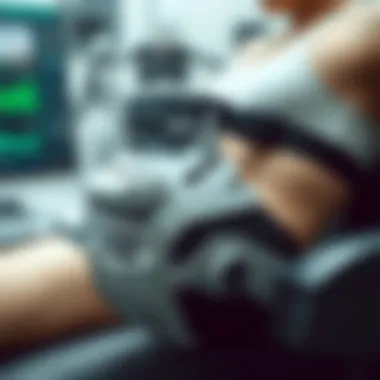
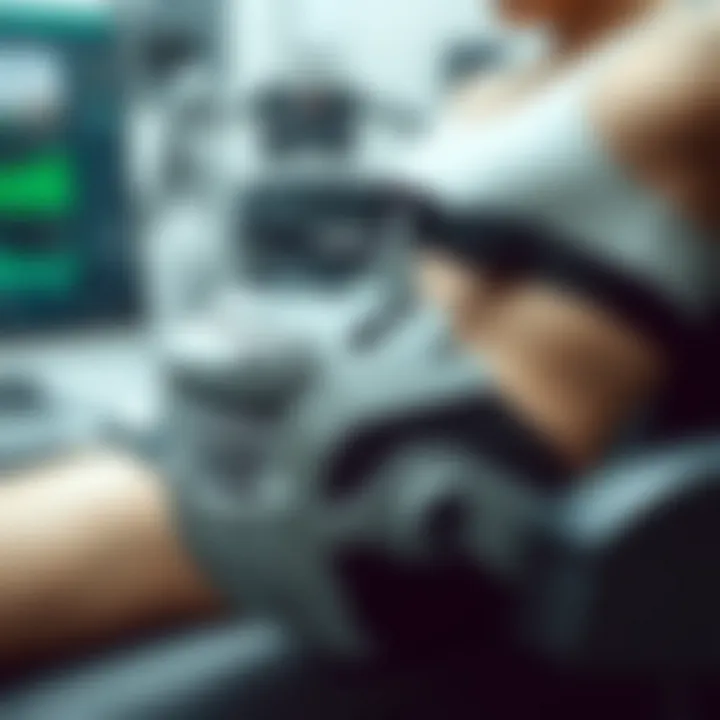
- Traditional hard-shell braces, like the Boston brace, have long been a staple for scoliosis management. Their rigid construction holds the spine in a corrected position, but they may lack comfort and compliance.
- Dynamic braces, which allow for some movement, have gained traction as they encourage physical activity, yet research regarding their long-term effectiveness compared to traditional models is ongoing.
- Hybrid models combine the strengths of both traditional and dynamic braces, fostering stability while providing room for some flexibility. Early data suggests these innovative braces may lead to even better outcomes for patients predisposed to non-compliance due to comfort issues.
In sum, comparative studies reveal significant insights into which brace types may benefit certain patient demographics more than others. As research continues to shed light on these tools, it’ll be crucial for clinicians to tailor bracing strategies to individual patient needs, ensuring the highest level of efficacy.
Challenges in Leg Brace Compliance
The efficacy of leg braces for scoliosis hinges not just on their design and technology but also on how well patients adhere to the prescribed usage. Compliance with wearing leg braces can significantly impact treatment outcomes, yet it remains a major challenge faced by many patients. Understanding these obstacles is crucial for practitioners and caregivers alike, as adherence directly correlates with the success of managing scoliosis effectively.
Adherence Rates in Scoliosis Patients
Research suggests that adherence rates among scoliosis patients can be alarmingly low, often falling below 50% in some cases. The reasons for this variability are manifold, with individual circumstances playing a significant role. A common trend reveals that children and adolescents, who are the primary cohort for scoliosis treatment, often struggle with compliance due to lifestyle factors and social pressures. For instance, wearing a brace may lead to concerns about body image or peer ridicule, creating a psychological barrier that outweighs the perceived benefits of treatment.
Additionally, the physical discomfort associated with wearing a brace—ranging from skin irritation to issues with mobility—can deter consistent use. Parents and clinicians need to keep an open line of communication to address these concerns and help patients understand the importance of their commitment.
Psychosocial Factors Influencing Compliance
Numerous psychosocial factors influence whether a patient will consistently wear their brace. Among these factors, a notable one is individual perception of scoliosis and its implications. Young patients may not understand the long-term consequences of neglecting their treatments. For instance, if they view scoliosis merely as a minor issue, they may not prioritize brace wear. Furthermore, adolescents are particularly sensitive to social validation, which can affect their willingness to wear a brace in public—to some extent, this is like grappling with a double-edged sword.
Family support also plays a critical role in boosting adherence rates. When caregivers show encouragement and are involved in the treatment process, patients are more likely to comply with wearing their braces. It's essential to foster an environment where the patient feels understood rather than isolated in their circumstance. When social and familial support systems rally around the patient, they are much better equipped to handle the psychological hurdles attached to wearing a brace.
Strategies to Improve Compliance
Improving brace compliance necessitates a multifaceted approach. Here are some actionable strategies:
- Education: Provide comprehensive information on scoliosis and the role of the brace in treatment. Resources like Scoliosis Research Society can be valuable.
- Customized Fit: Take the time to ensure the brace is tailored perfectly for the individual. An uncomfortable brace can undermine compliance right from the get-go.
- Peer Support Groups: Facilitate support groups where patients can share their experiences, challenges, and triumphs with others in similar situations. Shared experiences can foster a sense of community and reduce feelings of isolation.
- Involve Family: Engage families in setting goals and celebrating milestones, making the treatment path a shared journey.
- Regular Check-ins: Schedule periodic follow-ups that are not only clinical but also focus on discussing experiences and feelings regarding the brace.
- Gamification: Consider integrating technology that tracks usage and rewards consistent wear.
Monitoring brace compliance remains a pressing concern in scoliosis treatment. Bridging the gap between the medical community's expectations and the realities faced by patients is essential. The ultimate goal is to enhance the understanding between both medical providers and patients, ensuring that patients not only wear their leg braces but do so with the full confidence that they are taking a significant step towards their health and well-being.
Future Directions in Orthotic Support
In exploring the landscape of orthotic support for scoliosis management, one must acknowledge the continuous evolution of leg braces. The importance of this topic cannot be overstated, as it embodies the intersection of research, technology, and patient care. By understanding future directions, stakeholders can better harness advancements that enable effective treatment while enhancing patients' quality of life.
With the rapid pace of innovation in healthcare, there's a growing need to address specific elements like material innovations, user adaptability, and the integration of innovative technologies. Each of these factors can bolster the efficacy of leg braces and ensure they meet the diverse needs of patients battling scoliosis.
Research Innovations in Orthotics
Ongoing research is the bedrock of any significant advancement in medical fields, and orthotics are no exception. Recent efforts in materials science are paving the way for more lightweight and rigid options that offer greater support without compromising comfort. For instance, composite materials that blend flexibility with durability are becoming more common, allowing for braces that form closely to the body's natural contours.
Key areas of innovation include:
- Smart materials: These adapt to temperature, humidity, and even pressure, providing dynamic support that changes based on the user’s activity level.
- Lightweight breathable fabrics: Emerging synthetic fibers increase comfort and reduce skin irritation, which is crucial for long-term wear.
- Customizable designs utilizing 3D printing: Tailored orthotic designs can improve fit and function, enhancing compliance significantly.
Integrating Rehabilitation with Bracing
A holistic approach towards scoliosis management involves not just the use of bracing but also the incorporation of rehabilitation therapies like physical therapy. Coordination of care between orthotists and physical therapists can foster better outcomes.
By weaving together education about brace usage with therapeutic exercise programs, healthcare providers can empower patients. This might include:
- Strengthening exercises that improve stability and posture.
- Flexibility routines aiming to enhance recovery from muscle imbalances.
- Postural training which aligns with brace usage, ensuring that patients understand how to effectively use their devices in tandem with exercises.
Potential Impact of AI in Orthotic Development
Artificial Intelligence (AI) is beginning to find its place in various healthcare sectors, including orthotic development. Leveraging AI technologies has the potential to revolutionize the way braces are designed, manufactured, and tailored to individual patients.
Key implications of AI in orthotic support include:
- Predictive analytics: By analyzing patient data, AI can help in forecasting disease progression, leading to timely alterations in bracing strategies.
- Customized fit through machine learning: Algorithms can assess the nuances of each patient’s anatomy and recommend precise adjustments to the brace design.
- Remote monitoring: Wearable devices can provide real-time data on brace usage and effectiveness, enabling clinicians to promptly respond to issues and modify treatment plans as needed.
Innovations in orthotic support are not just about improving materials or designs; they represent a shift towards individualized care that prioritizes the patient experience.
In summary, the future of orthotic support in managing scoliosis is undoubtedly promising. As research, rehabilitation, and technology converge, they create a multifaceted ecosystem that supports not only the physical needs of patients but also their emotional and social well-being. The ongoing commitment to innovation will undoubtedly yield effective strategies that can make a marked difference in the lives of people living with scoliosis.



